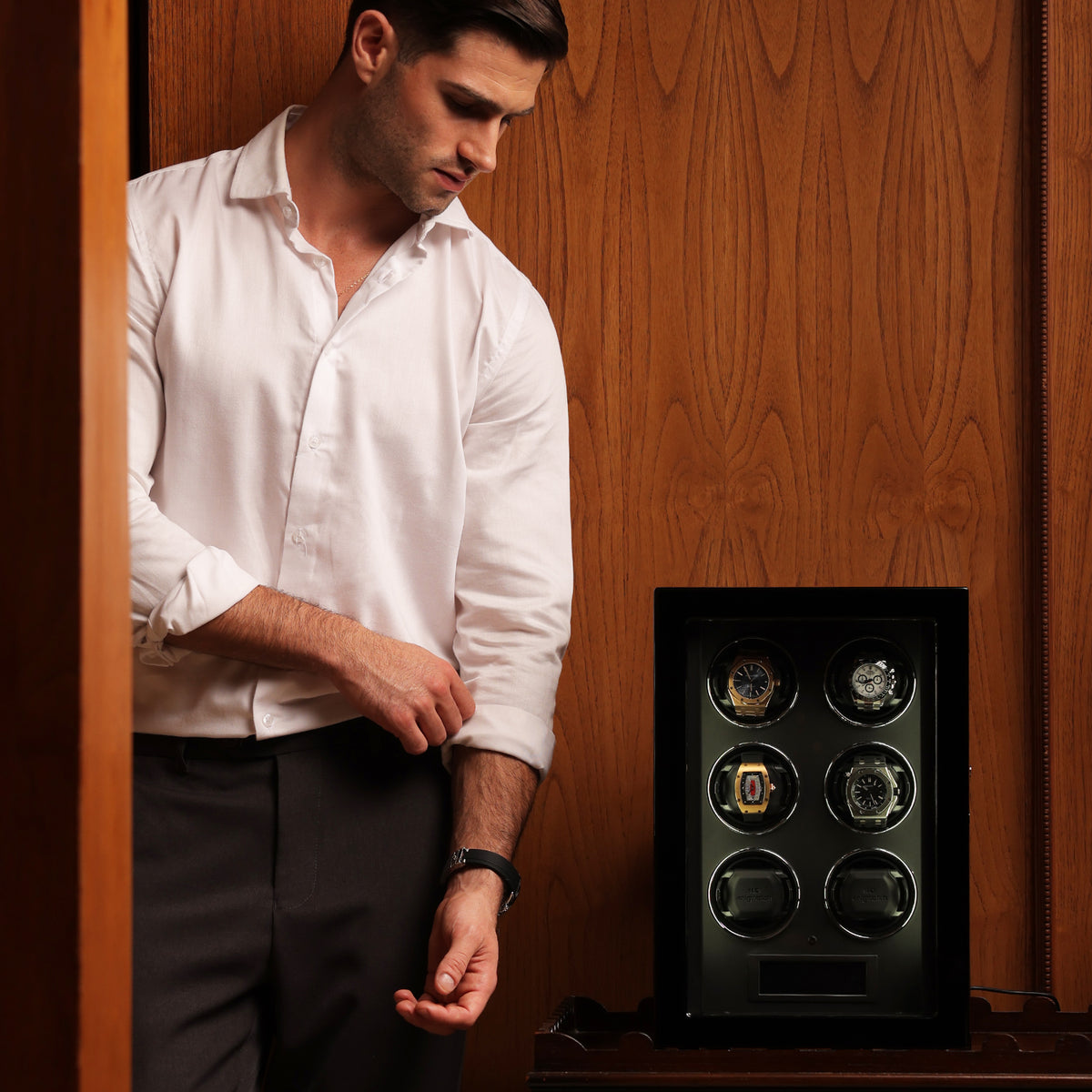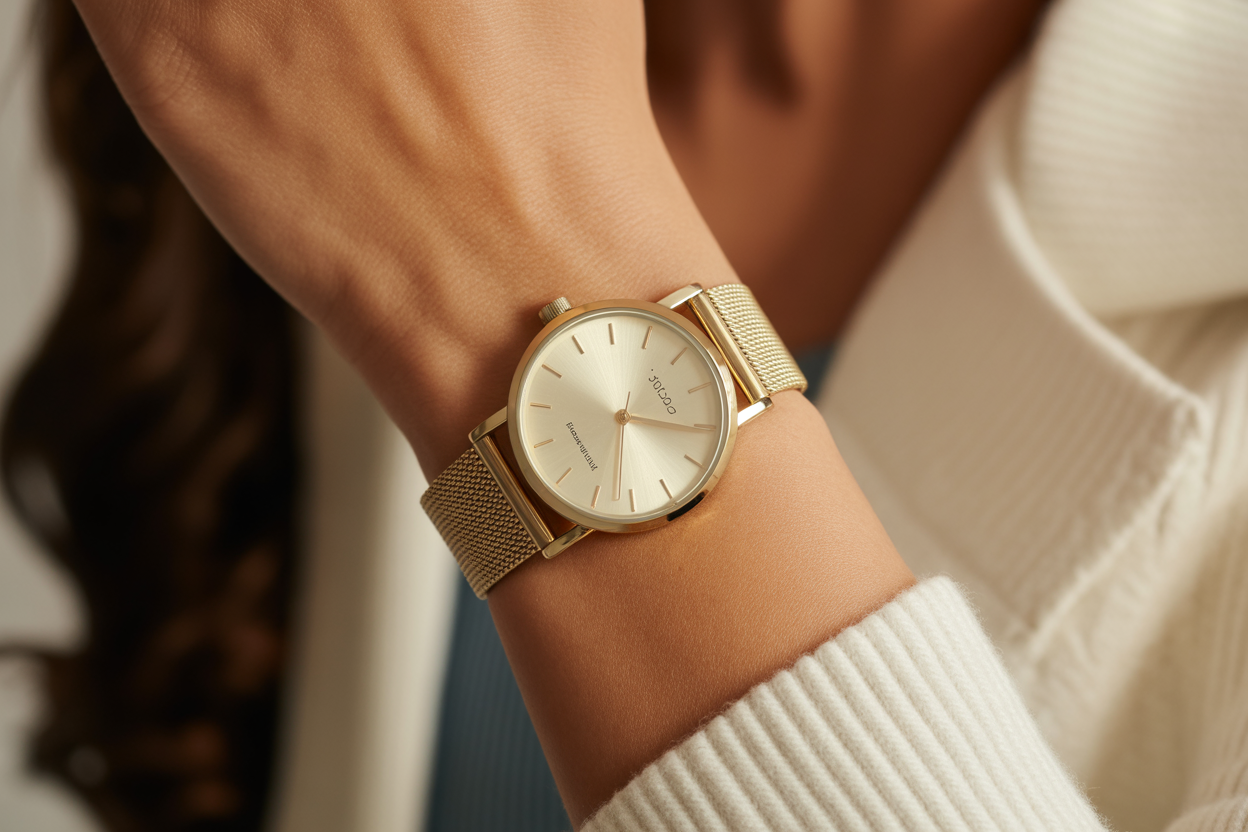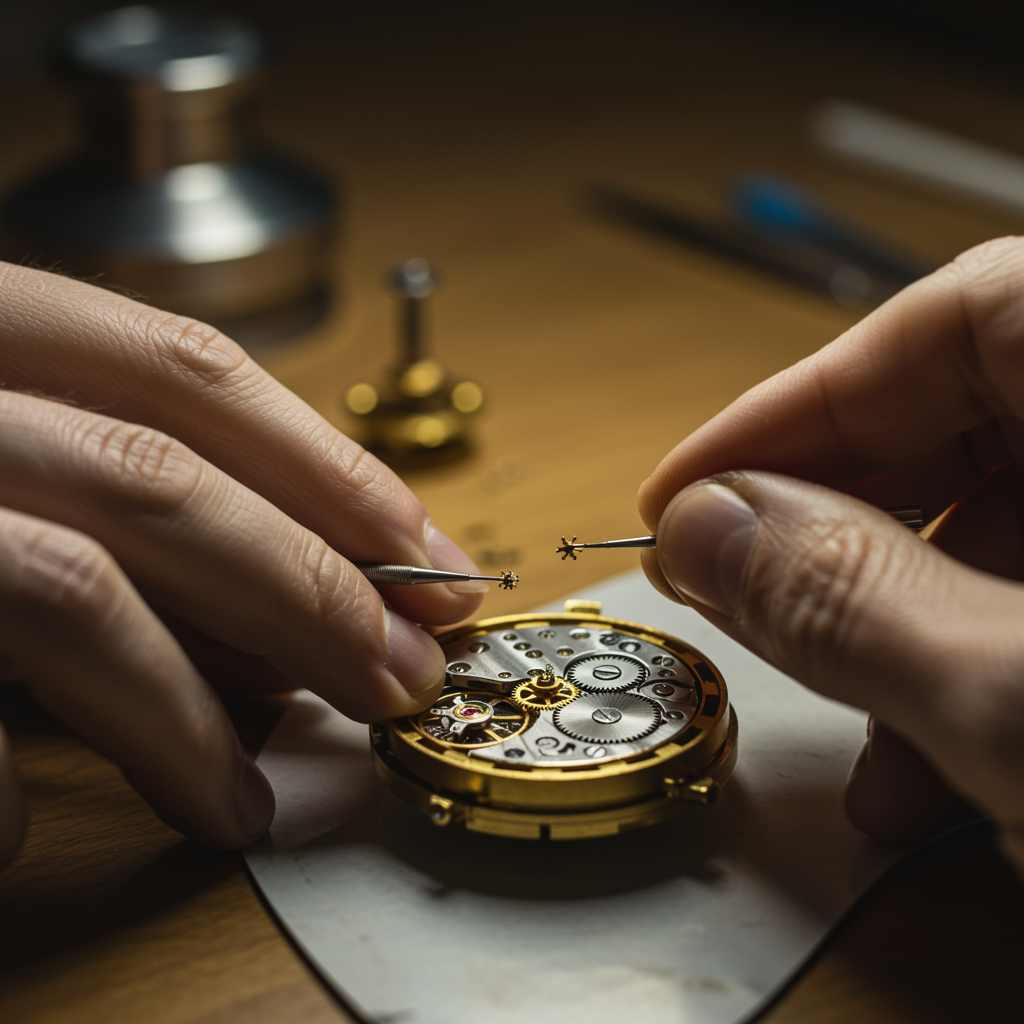Have you ever wondered how to take a link out of a watch to get the perfect fit? Whether you’ve just bought a new luxury timepiece or inherited a classic watch, resizing the band is often necessary. It ensures both comfort and style. According to a survey by the Federation of the Swiss Watch Industry, nearly 60% of watch owners have resized their watch at least once. This article will guide you through the process. It covers the tools required, step-by-step instructions, and common mistakes to avoid.
What Are Links in Watches?

Watch links are individual segments that make up a metal watch band or bracelet. You can add or remove these links to adjust the length of the band, ensuring a secure and comfortable fit around your wrist. Most watches have removable links, particularly those made from stainless steel, titanium, or precious metals.
Each link is connected to the next with pins or screws. The design allows for easy adjustments, but the process requires careful handling to avoid damaging the watch. Understanding how links work is essential before attempting to adjust your watch band.
Can You Add Links to Watches?
Yes, you can add links to a watch, especially if it feels too tight. Adding links can be done either by purchasing extra links from the manufacturer or using spare links provided at the time of purchase. Some luxury brands, like Rolex and Omega, often provide extra links specifically for this purpose.
Adding links, however, requires precision to ensure the bracelet remains symmetrical and balanced. Ideally, links should be added equally to both sides of the clasp to maintain the watch's centered position on the wrist. If you don't have the original links, you may need to contact the brand or a professional jeweler to ensure a perfect match.
What is a Watch Strap Called?
A watch strap is commonly referred to as a bracelet when made from metal, while leather, fabric, or rubber bands are often called straps. Bracelets consist of interconnected links, while straps are usually made of a single piece of material that wraps around the wrist.
Both types of watch bands have their unique features. Bracelets offer a more formal and luxurious appearance, while straps, particularly leather and fabric, offer a casual or sporty look. Understanding these distinctions can help you choose the right adjustment method for your watch band.
Tools You Need for Removing Watch Links
To remove watch links effectively, you will need the right tools. Essential tools include a watch link remover tool, a pin pusher, a small hammer, tweezers, and a micro screwdriver. Some watches may require specialized tools, such as those used for screw-type links.
Having the proper tools ensures a smoother process and reduces the risk of damaging your watch. If you plan on adjusting multiple watches or own luxury timepieces, investing in a high-quality watch repair kit can be a wise decision.
How to Remove Links from a Watch Without Pins
Removing links without pins involves a slightly different technique, often used for screw-type links. Instead of pushing out pins, you will need a micro screwdriver to unscrew the link connectors. These screws are typically found in high-end watches, as they offer more secure fastening.
Start by locating the screw heads on the side of the bracelet. Carefully unscrew them and slide the link out. Remember to keep the screws in a safe place, as they are small and easy to lose. Ensure the screws are tightened securely when reassembling the bracelet.
How to Remove Links from a Watch Without Pins

To remove links from a watch without pins, use alternative methods, especially if the bracelet uses screw links or snap-fit links. Adjust screw links with a precision screwdriver instead of a pin removal tool. Locate the screws on the side of the bracelet and carefully unscrew them to detach the desired links.
For snap-fit link watches, press a small release mechanism on the back of the link. Some snap-fit designs let you press a spring-loaded bar with a thin tool, like a paperclip or eyeglass screwdriver. Handle these designs delicately to avoid scratching the metal. If neither option fits your watch, seek professional help for specialized or vintage models with permanent links.
How to Adjust a Metal Watch Band Without Pins
Adjusting a metal watch band without pins depends on the bracelet design. Watches that use screw bars instead of pins require a precision screwdriver. Simply locate the small screws on the side of the bracelet and carefully turn counterclockwise to loosen and remove the desired links. Once you remove the links, reassemble the bracelet and tighten the screws firmly.
For expansion bands, commonly found in vintage and dress watches, you may not need tools. These bands often feature flexible segments. You can remove them by gently prying them apart with your fingers or a flat tool. However, adjusting them can be tricky, as the metal bends easily. If you’re working with a delicate or expensive timepiece, seek professional assistance.
How to Make a Watch Fit Tighter Without Removing Links
You can adjust your watch for a tighter fit without removing links by modifying the clasp type. Many watches feature micro-adjustment holes on the clasp, allowing you to shift the pin to a tighter setting. This small adjustment can make a significant difference in fit without the need to remove any links.
For watches without micro-adjustment clasps, installing a half-link is a great option. Half-links are smaller than standard links and can reduce the bracelet length by half the typical distance. If neither option is available, you could explore replacing the entire clasp with an adjustable one, such as a diver's clasp, which offers extended micro-adjustment settings for a precise fit.
What Are Quality Links?
Quality watch links are characterized by their material, construction, and durability. High-end watches like Rolex and Omega often use solid stainless steel or precious metals for their links. Solid links are far superior to hollow links because they provide better weight distribution, resist bending, and offer long-term durability.
Quality links also have smooth edges with no sharp corners, ensuring comfort on the wrist. The way links connect to each other matters as well—screw links and pins should be tight-fitting without gaps. Lower-quality watches often use folded metal links, which can loosen and bend over time. Investing in a watch with solid, well-crafted links ensures not only a better aesthetic but also longevity.
How Many Links Should Be on a Watch?

The number of links on a watch bracelet varies depending on the brand and model. On average, most watches come with 18 to 22 links, providing a standard wrist circumference of around 7 to 8 inches. However, the number can vary significantly, with smaller dress watches often featuring fewer links and larger dive watches having more to accommodate wrist flexibility.
A Rolex Submariner, for example, typically has 12 links, while a larger Omega Seamaster can come with up to 16 links. It's important to note that the total number of links includes both removable and fixed links. If you need additional links or replacements, check with the manufacturer to ensure compatibility with your specific model.
How Do I Adjust Watch Links?
Adjusting watch links involves carefully removing or adding links to achieve the perfect fit. To begin, you will need a link removal tool, a small screwdriver, or a pin pusher, depending on the bracelet design. Locate the removable links, often marked with small arrows on the inner side of the bracelet.
Gently push the pin or unscrew the screw link, depending on the design, and slide the link out. After removing the necessary links, reinsert the pin or screw and ensure it is secured properly. Always test the bracelet's fit before finalizing the adjustment to avoid having to repeat the process. If unsure, it’s best to consult a professional jeweler to avoid damaging the bracelet. For a more detailed guide on mastering watch sizing and adjustments, refer to this expert watch size guide for additional insights on achieving the perfect wrist fit.
How Do I Adjust a Watch Chain?
Adjusting a watch chain involves resizing the bracelet for a comfortable and secure fit. Chains, particularly those found on dress watches or pocket watches, often use delicate interlocked loops or solid links. To adjust them, identify the removable links, which may have a pin or screw mechanism. Use a link removal tool or small screwdriver to detach the links one at a time.
For more delicate chains without visible pins, seek professional assistance since thin metal bends easily. If the chain feels too loose but you cannot resize it further, add a clasp extender or install a different strap for a better fit.
How Many Links Should Be Removed From a Watch?
The number of links to remove from a watch depends on wrist size and the bracelet's length. A general rule is to remove enough links to ensure a snug fit without excessive tightness. The watch should stay in place without rotating, yet allow enough room for finger-width spacing between the wrist and bracelet.
Start by removing one or two links from each side of the clasp for balanced weight distribution. After each removal, test the fit and adjust further if necessary. If you’re unsure, consider removing links in pairs to maintain symmetry. Many watches come with extra links, so you can always restore the original length if needed.
How Many Links Is a Watch Supposed to Have?
The number of links in a watch varies based on the brand, size, and model. Most standard men's watches have between 18 and 22 links, while women's watches often have around 14 to 18 links. Luxury watches, such as Rolex, often have a fixed number of links, with a standard Rolex Submariner having 12 to 14 links.
The number of links also depends on the bracelet's original length. Larger models, such as dive watches, may come with additional links to accommodate wetsuits, while smaller models prioritize a minimalist design. When purchasing a watch, always check the specifications to ensure it fits your wrist comfortably or can be adjusted accordingly.
How Many Links Should Be on a Watch?

The number of links on a watch can vary significantly depending on the watch brand, model, and strap design. Typically, luxury watches such as Rolex, Omega, and TAG Heuer come with between 12 to 16 links, while standard metal bracelet watches often have between 10 to 14 links. The design of the bracelet, the size of the wrist, and the brand's styling preferences influence the total number of links.
When determining how many links your watch should have, consider the comfort and fit on your wrist. A properly sized watch should be snug but not tight, allowing minimal movement while avoiding excessive looseness. Manufacturers design some luxury watches with extra links so you can remove them for a perfect fit. Others include micro-adjustment systems on the clasp, letting you make minor size modifications without removing links. Always test the fit before deciding how many links to remove.
What Are Watch Chains Called?
Watch chains, often referred to as "bracelet links" or simply "bracelets," are the individual segments that make up a watch's metal strap. The links connect together, forming a flexible and adjustable band that secures the watch to your wrist. Historically, watch chains commonly appeared in pocket watches, where people called them fob chains or Albert chains, using them to attach the watch to clothing.
In modern wristwatches, chains or links enhance both aesthetics and functionality. Some watches feature solid links, crafted from a single piece of metal, providing superior durability. Others use folded links, which are lighter and more affordable but less durable. Understanding the type of chain your watch uses is essential for determining how to remove or add links effectively.
How Do I Adjust a Watch Chain?
Adjusting a watch chain involves either adding or removing links to ensure the watch fits comfortably on your wrist.
Steps to Adjust a Watch Chain:
- Determine the Fit: Place the watch on your wrist and assess how many links need adjusting.
-
Remove Links:
- Use a link removal tool or a precision screwdriver to push out the pins securing the links.
- If the watch uses screw pins, gently unscrew them using a flathead screwdriver. -
Add Links:
- Attach spare links provided by the manufacturer using the same method. - Ensure Balance: Make sure the clasp sits centrally on your wrist after adjustments for balanced weight distribution and comfort.
What Is a Rolex Strap Called?
People often refer to a Rolex strap as a bracelet or band, depending on the material and design. The most famous Rolex bracelets include the Oyster bracelet, known for its flat, wide links offering durability and a sporty appearance, and the Jubilee bracelet, recognized for its five-piece link design and more elegant finish.
Rolex also offers the President bracelet, which is exclusively available on the Rolex Day-Date models and some special editions, characterized by semi-circular links for a luxurious appeal. Each of these bracelet styles contributes to the watch's overall aesthetic, and the choice often depends on the wearer's style preferences and intended use of the watch. Regardless of the style, Rolex straps are designed for longevity and can be adjusted by adding or removing links to achieve a custom fit.
How Many Watch Links Should I Remove?

The number of links you should remove depends on the size of your wrist and the watch's initial length. On average, most people need to remove 2 to 4 links for a snug, comfortable fit. However, wrist sizes vary greatly, so it’s important to measure your wrist before deciding on the number of links to remove.
To determine the right number, wear the watch loosely and identify how much excess strap hangs off the wrist. Remove links evenly from both sides of the bracelet to ensure the clasp remains centered. If you’re unsure, it’s best to remove fewer links initially, as you can always adjust further. Remember, a properly fitted watch should be secure but not constrictive, allowing for slight movement without sliding too much.
What Does Links Mean in Sports?
In sports, the term "links" typically refers to links-style golf courses rather than watch components. A links course is a traditional type of golf course that originated in Scotland, characterized by its open layout, natural hazards, and minimal landscaping. The Old English word 'hlincas' inspired the term 'links,' referring to rising ridges or sandy dunes commonly found in coastal areas where people build these courses.
While unrelated to watches, the similarity in terminology can cause confusion. In the context of watches, "links" strictly refers to the individual segments of a metal watch bracelet. However, both uses share the idea of interconnected components working together to create a functional whole—whether it's the links of a watch or the design of a golf course.
How Many Links Is a Watch Supposed to Have?
The standard number of links for a watch can vary between brands and watch styles. Most wristwatches come with 12 to 16 links, while luxury models like Rolex can include up to 20 links for larger wristbands. However, the ideal number of links is determined by wrist size and personal comfort.
Many watches are designed with additional links to accommodate a wide range of wrist sizes, allowing the wearer to customize the fit by removing or adding links as needed. The manufacturer often provides extra links or micro-adjustments in the clasp for fine-tuning the fit. If you’re unsure, a professional jeweler can assist with resizing the watch to ensure an optimal fit without compromising the bracelet’s design.
How Do I Adjust Watch Links?
Adjusting watch links is a straightforward process, but it requires the right tools and careful handling to avoid damaging the bracelet. Begin by identifying how many links you need to remove for a comfortable fit. Place the watch on your wrist and determine the amount of excess strap length.
Once measured, use a link removal tool or a small screwdriver to remove the pins securing the links. Work on a flat, stable surface to prevent losing any small components. Reinsert the pins fully to secure the bracelet and prevent it from loosening during wear. If you feel uncomfortable making adjustments, visit a professional jeweler. They use specialized tools to ensure precision and avoid damage.
Can You Add Links to Watches?
Yes, adding links to a watch is possible and often necessary when the watch feels too tight on your wrist. Most watches, especially luxury brands like Rolex, Omega, and TAG Heuer, come with extra links or allow for additional links to be purchased separately. This process is ideal for those with larger wrists who need more space for a comfortable fit.
To add links, use a link pin removal tool or small screwdriver to detach the clasp area and insert the new link into the bracelet. Secure the link by reinserting the pin and ensuring it's flush with the bracelet. If you no longer have spare links, many manufacturers or authorized dealers sell additional links specific to your watch model. Professional jewelers can also assist with this process, ensuring the added links blend seamlessly with the existing design.
Can I Get Links Added to a Bracelet?
Yes, you can get links added to a bracelet, whether it's a watch bracelet or a standard jewelry bracelet. Many watch brands, including luxury models like Rolex and Cartier, design their bracelets with removable links, making it easy to extend the band if needed. Jewelry repair shops and watch retailers can typically perform this service.
Add links carefully to maintain the bracelet's visual balance and structural integrity. When working with a vintage watch or bracelet, finding matching links can present a challenge, especially if the design is discontinued. In such cases, jewelers can sometimes craft custom links to match the original style. Always ensure the links added are genuine and made from the same material to avoid mismatched finishes.
How to Ensure Watch Links Are Secure After Adjustments?
After adjusting your watch links, it's crucial to ensure they are properly secured to avoid the bracelet loosening or breaking. An improperly secured link can lead to the watch falling off, risking damage or loss. To check for security, gently tug the bracelet where the links were adjusted. If the links feel loose or shift slightly, they may need further tightening.
One effective way to secure the links is by using a pin hammer to tap the pins back into place firmly. Some watches also use screw pins, which can be tightened using a precision screwdriver. Double-check both sides of the bracelet, as some designs require symmetrical adjustments to ensure even weight distribution. If you're unsure, it’s best to have a professional jeweler inspect the adjustments for you.
Master the Art of Watch Link Adjustments
Learning how to take a link out of a watch is a valuable skill that ensures your timepiece fits perfectly for both comfort and style. From understanding watch links and the tools needed for adjustments to advanced tips like preventing sagging and identifying quality materials, mastering this process can save you time and money.
By following the step-by-step methods outlined above, you can confidently resize your watch, whether it's a classic Rolex, a metal bracelet, or a fashion timepiece. Always remember to handle your watch carefully, as delicate components can be easily damaged. If you're ever in doubt, professional jewelers and authorized dealers can assist with precise adjustments.
Are you ready to give your watch the perfect fit? Start today by gathering the right tools and trying these techniques to adjust your bracelet like a pro.

















